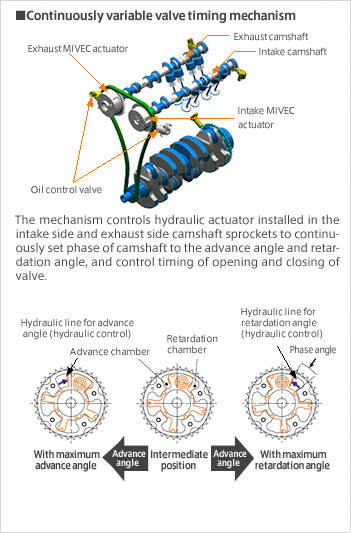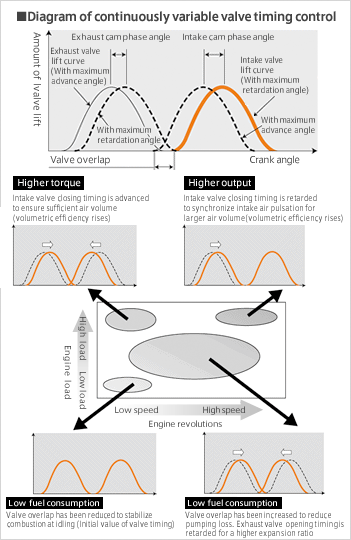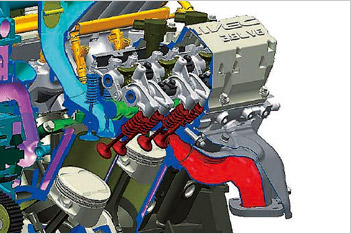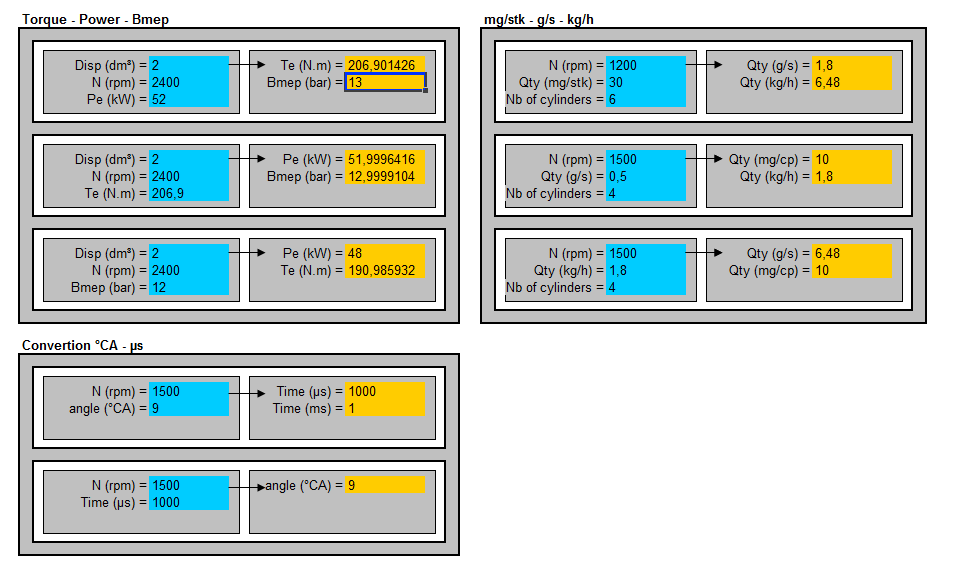Mitsubishi Motors has been focusing for a long time on technologies to controlled valve timing and amount of lift with the aim of achieving high power output, low fuel consumption, and low exhaust emission. The MIVEC engine was first used in 1992 in the Mirage, and since then they have been adding a number of enhancements to produce a better performance. In the Outlander launched in 2005 and Galant Fortis launched in 2007, they adopted a mechanism that continuously controls the intake and exhaust valve timing.
Continuously variable intake and exhaust valve timing MIVEC system
The 4B1 model MIVEC engine series installed in the Outlander and the Galant Fortis uses the continuously variable intake and exhaust valve timing MIVEC system that controls the intake and exhaust valve timing in accordance with the conditions. This system continuously varies intake side cam and exhaust side cam independently, so it enables more precise control based on engine revolutions and load.
N.B: MIVEC (Mitsubishi Innovative Valve timing Electronic Control system) is the general name for all engines equipped with the variable valve timing mechanism developed by Mitsubishi Motors.


In addition, they have incorporated the following new technologies in the 4B1 MIVEC engine series in order to further improve the performance.
Weight reduction
Mitsubishi incorporated the following weight reducing technologies to reduce the dry weight of the 4B12 engine by 16 kilograms compared to the former engine model (4G69).
- Adopted aluminum die cast cylinder block
- Adopted plastic components in the cylinder head cover, intake manifold, etc.
- Adopted cam direct drive type valve train (removal of the rocker arms)
- Adopted serpentine auxiliary drive method (downsizing of the auxiliary equipment arrangement)
- Modulation of the balancer shaft and the oil pump
Reducing the weight of the engine naturally leads to increased acceleration performance and fuel economy. It also contributes to handling performance.
Reduction of friction loss
Reducing friction is an effective way to improve output and fuel economy. With the 4B1 engine series, they adopted the following items to reduce friction.
- Friction of the valve train decreased by reducing the valve spring load and implementing elastic grinding of the valve stems.
- 0W-20 grade low-viscosity engine oil has been adopted. In particular they reduced the friction when the vehicle is warming up which contributed to reduce furthermore the fuel consumption.
Rear exhaust engine layout
In order to reduce exhaust emission, Mitsubishi adopted a rear exhaust layout. They shortened the distance from the exhaust port to the under-floor catalyst, so that the exhaust gas reach the catalyst without its temperature dropping, which made quick activation of the catalyst for cold-start possible. For this reason, they removed the former closely-coupled catalyst in the exhaust manifold in the Outlander and realized a better environmental.
Switching valve timing and lift MIVEC system (intake side)
The 6G75 (V6 3.8-liter) engine installed in Pajero uses a mechanism that switches the valve timing and the amount of valve lift of the dual-intake valve camshaft according to the number of revolutions, from the low speed mode to the high speed mode as explained below:

As a short conclusion, thanks to these innovations, Mitsubishi MIVEC engine managed to respect 2010 norms meanwhile performances and fuel economy were improved.
Source: Mitsubishi Motors
Romain Nicolas opinion:
This engine combines several innovations in particular on valve train side which enables a better trade-off between performances and emissions. This is a complex solution in terms of development, however it is less costly than hybridizing the powertrain and less intrusive in the vehicle integration. To me, variable valve actuation and timing are the best way to increase performance, reduce emissions and fuel consumption at a reasonable price, depending on the vehicle segment of course. The question would be which variable valve actuation system is the most efficient: This one, the fiat multi-air system or the complete camless system currently developed by Valéo? At which point this kind of technology becomes less favorable than hybridization? Is there the same potential for diesel engines?





















Hi Romain Nicolas,
You forget the Vtec developped by Honda! Well, even though it’s main goal it’s not really efficiency 🙂
You can’ developp this kind technologies for diesel engines as there is no valves on them to control.
Hello Nicolas,
Indeed there are plenty of other technologies regarding variable valve actuation/timing: Valvetronic BMW, Valvelift Audi, MultiAir Fiat, … The aim of this article was only to depict the Mitsubishi system (even though I prefer Vtec system on K20 engine 🙂 .
On diesel engine, it is coming but slower because there is less need of such a system as diesel engine load is not controlled by a throttle!
Yes! Finally something about Electronic Engine Management.
wow
any tricks to set valve timming 0n 2115 lancer having issue locking up on rotation by hand have marks correct is there any thing else i can do
Pingback: Recommended SUV Cars For Road Trip – lexique de la propriété intellectuelle